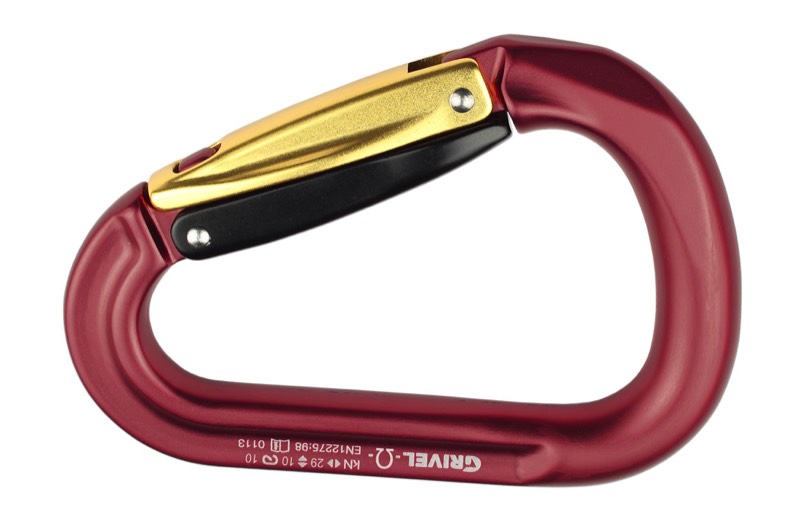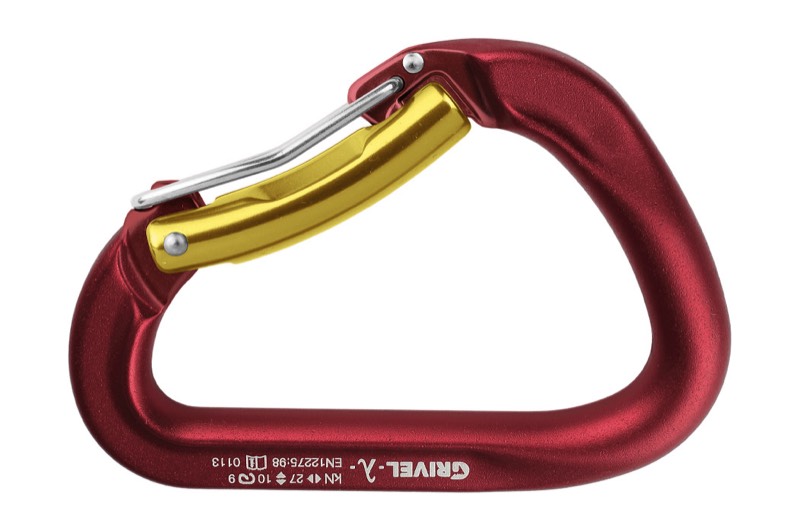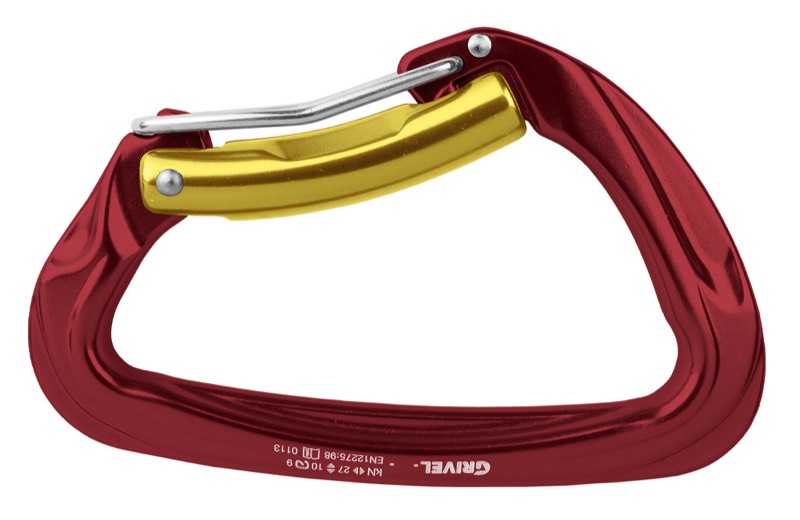Grivel Twin Gate Carabiners - Are Two Gates Better Than One?
Like everyone who saw Grivel’s Twin Gate Carabiners when they were introduced last year, I was intrigued by their unconventional gate construction. Billed as auto-locking carabiners, the new Twin Gates lacked any visible locking sleeve. Instead, Grivel was using two opposing gates to create a locking “mechanism.” While the design is similar to Rock Exotica’s BiWire biner (in production for many years), Grivel's version has a different pivot point for each gate. This creates a locking effect similar to what occurs when you have two carabiners with the gates flipped and opposed. This setup makes the Twin Gates at least as secure as other lockers, but perhaps more importantly, it also allows you to clip gear or a rope into the biner with one hand. I’ll talk more about this in a minute, but first let’s look at some of the more conventional features on the Twin Gate biners.

Grivel Mega K6G

Grivel Lambda K7G

Grivel Sigma K8G
The gate design is available on three body shapes: a small pear (Mega), an offset pear (Lambda) and an offset D (Sigma).
The Mega is obviously optimized for belaying. The biner’s large round-stock body works well with almost all belay devices (it’s a tight fit with a GriGri) and offers plenty of interior space for racking gear. The biner uses two flattened gates, which create a snag-free surface and eliminate the risk of the rope or belay loop catching on a gate. This construction eliminates the risk of the rope working open the locking sleeve, something that can happen with conventional screwgates.
The Lambda and Sigma both use a modified twin gate with an external wire gate and internal round-stock keylock gate. I suspect that Grivel uses this construction as it may be easier to manufacture when compared to the more complex gate on the Mega. And while it may not look as sleek as the Mega’s gate, it seems to offer similar benefits in terms of security. The Lambda’s modified pear shape is ideal for belaying, while the Sigma’s D shape clearly suggests it’s suited for any situation that requires a small locking carabiner. Like the Mega, the wire gate Twin Gate biners are a bit of a tight fit with a GriGri, but they will work this ubiquitous belay device.
The Mega is obviously optimized for belaying. The biner’s large round-stock body works well with almost all belay devices (it’s a tight fit with a GriGri) and offers plenty of interior space for racking gear. The biner uses two flattened gates, which create a snag-free surface and eliminate the risk of the rope or belay loop catching on a gate. This construction eliminates the risk of the rope working open the locking sleeve, something that can happen with conventional screwgates.
The Lambda and Sigma both use a modified twin gate with an external wire gate and internal round-stock keylock gate. I suspect that Grivel uses this construction as it may be easier to manufacture when compared to the more complex gate on the Mega. And while it may not look as sleek as the Mega’s gate, it seems to offer similar benefits in terms of security. The Lambda’s modified pear shape is ideal for belaying, while the Sigma’s D shape clearly suggests it’s suited for any situation that requires a small locking carabiner. Like the Mega, the wire gate Twin Gate biners are a bit of a tight fit with a GriGri, but they will work this ubiquitous belay device.
I've been using these carabiners since late last year and I have to say the design works. There’s no denying that the biners have a bit of learning curve, but with some practice, both gate systems can be operated with one hand. The technique that I’ve found most effective for clipping into gear involves holding the carabiner with the basket facing up, partially pulling open the inner gate with my thumb and index finger and then pushing out the outer gate with the back of my middle finger. Climbers with larger hands may simply be able to push out the outer gate with their thumb and middle finger. At this point, all you need to do is push the biner over whatever you’re clipping; don’t worry about opening the inner gate, just push it over the gear or sling. Unclipping is significantly easier. Simply pull open the inner gate and pull the biner away from the gear. In my experience, climbers with smaller hands will find the Lambda and Sigma (with their wire gates) easier to use than the Mega. And while I could operate all the biners with the gloved hands, the wire gate Lambda and Sigma seemed easier to use – especially when wearing thicker gloves.
Now as I mentioned earlier, these are all admirable qualities for a locking carabiner, but for me they do not represent the Twin Gate’s key win. When any of these biners are in a fixed position (clipped into a bolt, used in a draw), you can easily clip gear or a rope into the biner with one hand. With traditional auto-lockers, you would need to use one hand to open the gate and the other hand to clip the gear. Screwgates can be used with one hand, but then require that you manually lock the gate.
So, where’s the real win with this option? Consider combining two Sigma biners on a quickdraw. Suddenly climbers can have a great crux draw that they can actually clip almost as easily as a regular draw, but with the security of locking biners. And this easy-to-clip added-security does not have to just be used on adventure routes. Sport climbs that might have a section with a long fall could also benefit from a Sigma Twin Gate draw. In fact, if I was working a route and repeatedly taking long falls at one section, I would swap the rope-end Sigma for the rope-saving larger round stock of the Lambda. Seriously, this setup is ridiculously easy to clip and significantly increases safety. In this arrangement I found pinch clipping the rope to be a touch easier than finger clipping, but both methods were more than acceptable after a bit of practice.
Ok, it’s pretty clear that I’m impressed with the Twin Gate design. Yes, there is a learning curve, but beyond this minor issue, these really are an improvement over conventional lockers. They’re a great bit of kit and it’s worth adding a few to your rack.
So, where’s the real win with this option? Consider combining two Sigma biners on a quickdraw. Suddenly climbers can have a great crux draw that they can actually clip almost as easily as a regular draw, but with the security of locking biners. And this easy-to-clip added-security does not have to just be used on adventure routes. Sport climbs that might have a section with a long fall could also benefit from a Sigma Twin Gate draw. In fact, if I was working a route and repeatedly taking long falls at one section, I would swap the rope-end Sigma for the rope-saving larger round stock of the Lambda. Seriously, this setup is ridiculously easy to clip and significantly increases safety. In this arrangement I found pinch clipping the rope to be a touch easier than finger clipping, but both methods were more than acceptable after a bit of practice.
Ok, it’s pretty clear that I’m impressed with the Twin Gate design. Yes, there is a learning curve, but beyond this minor issue, these really are an improvement over conventional lockers. They’re a great bit of kit and it’s worth adding a few to your rack.
You can check out the all of Grivel's new Twin Lock biners at Grivel's website.


